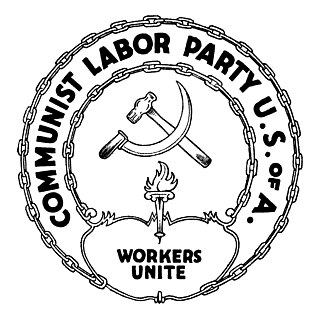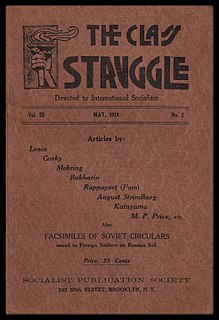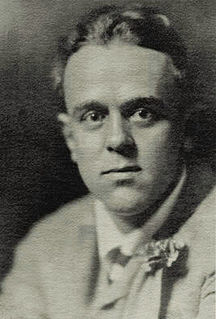Related Research Articles

The Socialist Party of America (SPA) was a socialist political party in the United States formed in 1901 by a merger between the three-year-old Social Democratic Party of America and disaffected elements of the Socialist Labor Party of America which had split from the main organization in 1899.

The Communist Labor Party of America (CLPA) was one of the organizational predecessors of the Communist Party USA.

Charles Emil Ruthenberg was an American Marxist politician and a founder and head of the Communist Party USA (CPUSA).
Radicalism was a historical political movement within liberalism during the late 18th and early 19th centuries and a precursor to social liberalism. Its identified radicals were proponents of democratic reform in what subsequently became the parliamentary Radicals in the United Kingdom.

The Socialist Propaganda League of America (SPLA) was established in 1915, apparently by C.W. Fitzgerald of Beverly, Massachusetts. The group was a membership organization established within the ranks of the Socialist Party of America and is best remembered as direct lineal antecedent of the Left Wing Section of the Socialist Party and its governing National Council — the forerunner of the American Communist movement.

Benjamin "Ben" Gitlow was a prominent American socialist politician of the early 20th century and a founding member of the Communist Party USA. During the end of the 1930s, Gitlow turned to conservatism and wrote two sensational exposés of American Communism, books which were very influential during the McCarthy period. Gitlow remained a leading anti-communist up to the time of his death.

Alfred Wagenknecht was an American Marxist activist and political functionary. He is best remembered for having played a critical role in the establishment of the American Communist Party in 1919 as a leader of the Left Wing Section of the Socialist Party. Wagenknecht served as Executive Secretary of the Communist Labor Party of America and the United Communist Party of America in 1919 and 1920, respectively.

The Left Wing Section of the Socialist Party was an organized faction within the Socialist Party of America in 1919 which served as the core of the dual communist parties which emerged in the fall of that year—the Communist Party of America and the Communist Labor Party of America.
The Finnish Socialist Federation was a language federation of the Socialist Party of America which united Finnish language-speaking immigrants in the United States in a national organization designed to conduct propaganda and education for socialism among their community.

Louis C. Fraina was a founding member of the American Communist Party in 1919. After running afoul of the Communist International in 1921 over the alleged misappropriation of funds, Fraina left the organized radical movement, emerging in 1926 as a left wing public intellectual by the name of Lewis Corey. During the McCarthy era, deportation proceedings were initiated against Fraina-Corey. After a protracted legal battle, Corey died of a cerebral hemorrhage before the action against him was formally abandoned.

Maximilian "Max" Cohen was an American socialist politician of the early 20th Century. Cohen held a series of important posts during the pivotal year of 1919, including Secretary of the Left Wing Section of the Socialist Party for Local Greater New York, Secretary of the Left Wing National Council, and business manager for the New York Communist. Cohen was also a founding member of the Communist Party of America in that same year.

The New York Communist was a short-lived weekly newspaper issued by the Left Wing Section of the Socialist Party of Local Greater New York, encompassing the New York City metro area. The paper was edited by the radical journalist and war correspondent John Reed. Only 10 issues of the paper were produced during 1919 before the publication was absorbed by The Revolutionary Age following the Left Wing National Conference of June 1919.

David Paul Berenberg was an American socialist teacher, editor, and writer. He is best remembered as a founder and editor of The American Socialist Quarterly, the theoretical magazine of the Socialist Party of America (SPA) during the 1930s.

The Class Struggle was a bi-monthly Marxist theoretical magazine published in New York City by the Socialist Publication Society. The SPS also published a series of pamphlets, mostly reprints from the magazine during the short period of its existence. Among the initial editors of the publication were Ludwig Lore, Marxist theoreticians Louis B. Boudin and Louis C. Fraina, the former of whom left the publication in 1918. In the third and final year of the periodical, The Class Struggle emerged as one of the primary English-language voices of the left wing factions within the American Socialist Party and its final issue was published in 1919 by the nascent Communist Labor Party of America.
Eteenpäin was a Finnish-language daily newspaper launched in New York City in 1921. The paper was the East Coast organ of Finnish-American members of the Communist Party USA. The paper moved to Worcester, Massachusetts in 1922 and to Yonkers, New York in 1931. In 1950 Eteenpäin was merged with the Communist Party's Midwestern Finnish-language daily, Työmies to create Työmies-Eteenpäin, which continued to be published from Superior, Wisconsin into the 1990s.

The Communist Party USA has held thirty official conventions including nomination conventions and conventions held while the party was known as the Workers Party of America, the Workers (Communist) Party of America and the Communist Political Association. There were also a number of congresses held by the earlier organizational predecessors of the party, including the Communist Labor Party of America, the United Communist Party and two groups known as the Communist Party of America. The Communist Party's 30th National Convention took place on 13 to 15 June 2014 in Chicago.

The Russian Socialist Federation was a semi-autonomous American political organization which was part of the Socialist Party of America from 1915 until the split of the national organization into rival socialist and communist organizations in the summer of 1919. Elements of the Russian Socialist Federation became key components of both the Communist Party of America and the rival Communist Labor Party of America as "Russian Federations" within these organizations. Following the unification of these two groups in 1921, the resulting unified Russian Communist Federation gradually evolved into the so-called Russian Bureau of the Communist Party, USA.

The Revolutionary Age was an American radical newspaper edited by Louis C. Fraina and published from November 1918 until August 1919. Originally the publication of Local Boston, Socialist Party, the paper evolved into the de facto national organ of the Left Wing Section of the Socialist Party which battled for control of the Socialist Party throughout the spring and summer of 1919. With the establishment of the Left Wing National Council in June 1919, the paper was moved from Boston to New York City gained status as the official voice of the nascent American communist movement. The publication was terminated in August 1919, replaced by the official organ of the new Communist Party of America, a weekly newspaper known as The Communist.
Isaac Edward "Ed" Ferguson (1888–1964) was a North American lawyer and political activist. A founding member of the Communist Party of America, forerunner of the Communist Party, USA, Ferguson is best remembered a co-defendant and attorney in a highly publicized 1920 trial together with party leader C. E. Ruthenberg for alleged violation of New York state law against so-called "criminal anarchism." Following conviction and a term served at Sing Sing prison, Ferguson withdrew from radical politics to become a prominent Chicago civil rights attorney.
The Revolutionary Policy Committee (RPC) was an offshoot of the so-called "Militant" faction in the Socialist Party of America during the middle-1930s. The group sought to transform the SP into a revolutionary socialist organization from its origins as a social democratic political party.
References
- ↑ Theodore Draper, The Roots of American Communism. New York: Viking Press, 1957. Page 145.
- ↑ "Manifesto," in Revolutionary Radicalism, 706
- ↑ Louis C. Fraina (ed.), The Revolutionary Age, v. 2, no. 1 (July 5, 1919), pp. 6-9, 14-15. The complete run of The Revolutionary Age was published as an elephant folio book by Greenwood Reprint Corp., Westport, CT, in 1968 as part of their series "Radical Periodicals in the United States, 1890-1960." The publication was simultaneously released on microfilm by Greenwood.
- ↑ "The Left Wing Manifesto (Issued on Authority of the Conference by the National Council of the Left Wing)," in Revolutionary Radicalism, 716